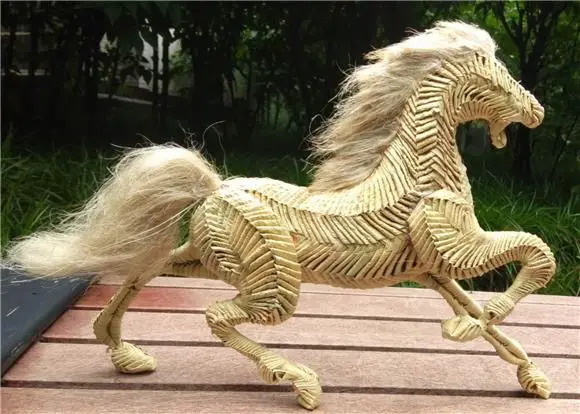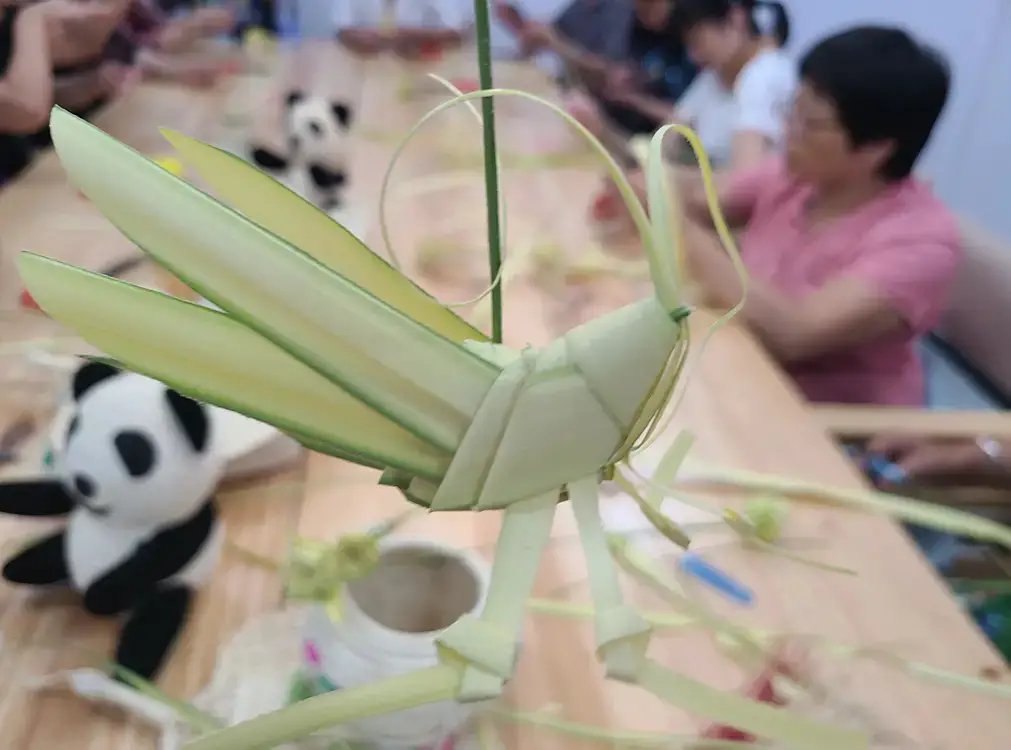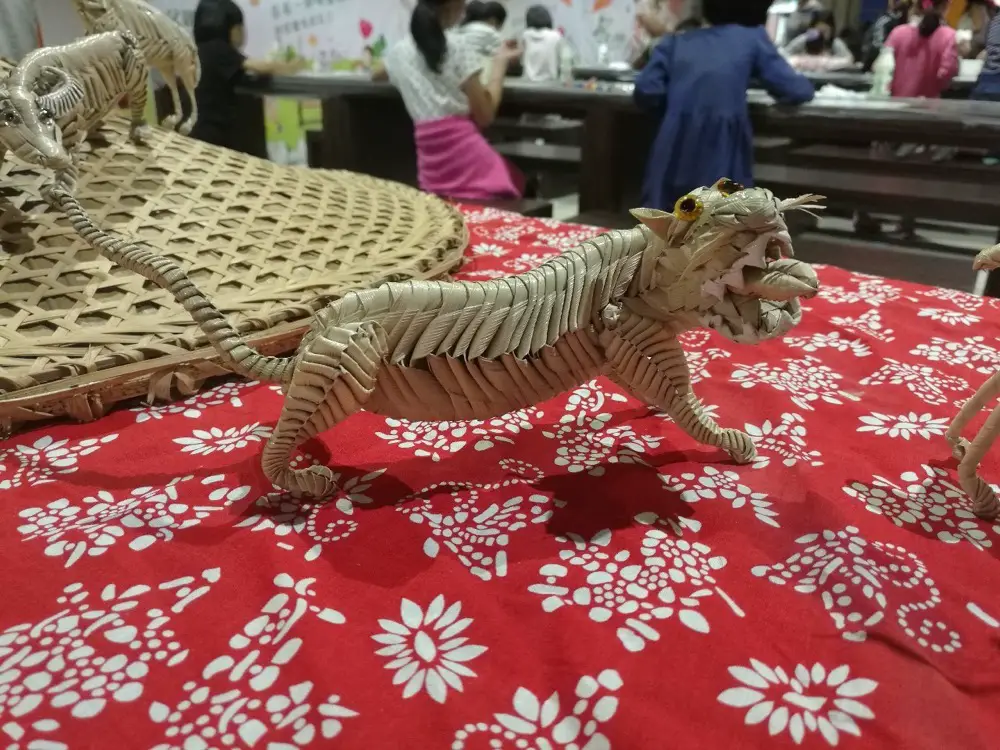Chinese palm fibre, also called Zongbian, is one of the traditional handicrafts of the Han ethnic group, crafted from palm tree leaves. Palm grass products have a long history, with the main production of Zongbian in the Yangtze River basin located in the southern part of Shaanxi, particularly in Hanzhong. Sichuan, Guizhou, Hunan, and Jiangnan are also renowned for Sichuan Xinfan Zongbian and Hunan Zongbian toys. Additionally, Guizhou Tangtou Zongbian baskets and Zhejiang Wuyi Zongbian straps are also well-known. Sichuan Xinfan Zongbian is a traditional product of Xinfan Town in Xindu County, with a history of over 200 years.
Zongbian History
In the southern regions of China, especially in the Yangtze River basin and southern China, there is a unique rain gear known as “suoyi” made from woven palm leaf fibers. This simple yet powerful rain gear has accompanied Chinese farmers through countless rainy seasons, becoming an indispensable part of their daily lives.

As early as the time of the “Book of Songs,” there were records of “he suoyi he li” (何蓑何笠), demonstrating the long history of suoyi. The Tang Dynasty poet Zhang Zhihe’s famous lines, “Qing arrow bamboo hat, green suoyi clothes, in the slanting wind and light rain, no need to return,” depicted the poetic scene of fishermen leisurely enjoying the rain. This not only illustrates the prevalence of suoyi in ancient China but also reflects its close connection to people’s daily lives.
The crafting process of suoyi is not complicated but requires exquisite craftsmanship. Material selection, cutting, polishing, weaving—each step tests the skill and patience of the craftspeople. When palm leaves gradually transform into a rainproof and windproof suoyi in the hands of artisans, there is a sense of satisfaction and pride that cannot be replaced by anything.
Beyond its practicality, suoyi carries rich cultural connotations. In the Zhejiang Kua Cangshan area, the South China tiger was said to be a fierce beast. According to legend, someone once wore suoyi in a critical moment, causing a tiger to mistake them for a monster and averting danger. This undoubtedly added a mysterious aura to suoyi.
Furthermore, it is said that in ancient times, Yu Yao, before becoming a king, stripped off the fur of a certain palm tree and made it into suoyi. Wearing it, he received blessings from the people, turning suoyi into sacred clothing, admired and loved by mountain people. It served both as protection against rain and beasts and as a commemoration and respect for ancestors.
Moving to the Ming Dynasty, it is said that a young emperor Zhu Yuanzhang also wore suoyi while tending to cattle and cutting grass to seek shelter from rain and sun. This undoubtedly proves the popularity and practicality of suoyi, providing us with a window to understand history and culture.
With the development of society and technological progress, many traditional handicrafts are gradually being replaced by modern products. However, suoyi, as a handicraft with both practical and cultural value, continues to be widely used and inherited in the rural areas of southern China. This is not only due to its practicality but also because of the nostalgia it carries for tradition and rural life.
Today, suoyi is no longer a necessity in people’s daily lives, but it still holds a special place in many hearts. It symbolizes the farmers, witnesses history, and serves as a carrier of culture and tradition. When it rains, many people are still willing to put on suoyi, as if walking in the rain allows them to converse with history and tradition, experiencing the profound cultural heritage.
Zongbian Material Selection
Zongbian, a traditional craft filled with rural charm, has become an integral part of rural culture in southern China due to its unique production techniques and exquisite finished products. It is not only a practical handmade product but also a carrier of emotions and memories.
The production of Zongbian is highly seasonal, typically taking place in spring and autumn. During this time, fresh palm leaves are soft and elastic, providing the best materials for production. People select tender green palm leaves, undergo meticulous processes such as cutting, twisting, and dyeing, ultimately creating soft and pristine palm silk materials. This series of complex crafting processes not only showcases the artisans’ superb skills but also emphasizes their attention to detail and pursuit of perfection.
Zongbian comes in various varieties, including shoes, fans, bags, hats, cushions, boxes, and toys. Each Zongbian product embodies the painstaking effort and wisdom of the craftsmen, carrying people’s aspirations and pursuit of a better life. Among Zongbian crafts, the woven bag is the most common product. Craftsmen use a clever interlacing technique, crossing equidistant warp threads into diamonds, and threading two weft threads through the four corners of each diamond to create exquisite patterns. This technique, known as the “pepper eye technique,” ensures that the woven bag is not only sturdy and durable but also highly decorative.
In addition to woven bags, shoes and fans are also classic works of Zongbian craftsmanship. Craftsmen use a tight weaving method to tightly weave palm silk together, forming sturdy shoe soles and fan surfaces. Simultaneously, they employ various decorative techniques such as dyeing, embossing, and relief work to weave beautiful patterns on the shoe surfaces and fan surfaces, such as flowers, birds, and animal shapes, making the products more lively and interesting.
Hats, mats, and other products are also essential in Zongbian craftsmanship. These products often use the herringbone weaving method, making the finished products more even and attractive. Products like bags, made from models woven with wood, paper, clay, and other materials, focus more on the decorative patterns. Craftsmen, through intricate weaving techniques, create beautiful patterns on the surface of bags, such as flowers, birds, fish, and insects, making each piece resemble a fine painting, captivating people’s hearts.
For craftsmen pursuing higher artistic effects, they prefer to use pure white palm silk to weave objects. These objects are woven as beautifully as silk, appearing noble and elegant. During the weaving process, they often use colored palm silk for decoration, employing techniques like embossing, relief work, and weaving to create various colorful patterns, making the finished products more vibrant and colorful.
As an important part of Chinese traditional culture, Zongbian craftsmanship carries rich cultural connotations and historical heritage. It is not only a practical item in rural life but also a crucial carrier for expressing emotions and preserving culture. In today’s era of mechanized production, handmade Zongbian crafts are increasingly precious. They carry the warmth and emotions of the craftsmen, conveying a unique sense of rural sentiment and cultural memory.
Chinese Zongbian Craft
During the Jiaqing period of the Qing Dynasty (1796-1820), rural women in Xinfan began using palm leaves to weave sandals and sandals. This simple yet practical craft gradually gained popularity, and by 1850, Zongbian had evolved into a specialized industry.
In the early years of the Republic of China, Zongbian coolie hats became popular in Sichuan. These hats were lightweight and breathable, providing excellent sun protection for people at the time. With the passage of time, from the 1930s to the 1940s, the Zongbian industry reached a prosperous stage.

Xinfan Zongbian is famous for its diverse techniques, high-quality materials, and beautiful appearance. Among them, there are unique weaving methods such as pepper-eye hollow flowers and magpie beak non-hollow. These unique techniques make Zongbian bags time-saving, material-saving, light, and flexible. The decorative patterns are exquisite and beautiful, and non-hollow flowers and other patterns are evenly distributed on both sides, making the appearance very pleasing.
Moreover, Zongbian has profound cultural connotations. It is not only a practical handmade product but also a heritage of traditional culture. In the busy modern life, people are increasingly pursuing a simple and natural lifestyle, and Zongbian happens to meet this demand. Its natural, simple, and minimalist characteristics have led more and more people to pay attention to and love this traditional craft.
However, with the acceleration of the modernization process, many traditional crafts face the danger of being lost. To protect and inherit this valuable cultural heritage, the government and various sectors of society should increase support for Zongbian craftsmanship, encourage practitioners to carry out skill inheritance activities, and allow more people to understand and master this traditional craft. At the same time, relevant content should be added to the education field to cultivate more Zongbian skilled talents, injecting new vitality into the sustainable development of this industry.
Xinfan Zongbian
Shoes, hats, woven bags, fruit box covers, toys, fans, and chairs are the seven major categories with dozens of color patterns. For example, the slippers use hemp rope as the warp and palm silk as the weft, woven densely like silk, with decorative patterns such as colored, birds, and flowers. The colors are coordinated and beautiful, and the sole is two to three layers thick, sturdy, and wear-resistant. Hat types mostly use the herringbone weaving method, making the finished hat slightly stretchable; when worn, it is moderately loose and tight, suitable for various head shapes. There are various types, including coolie hats, ceremonial hats, hollow flower hats, and children’s hats. Woven bags often use a mixed weaving method of colored palm silk, with various shapes such as square, round, peach-shaped, fan-shaped, lotus leaf-shaped, crescent-shaped, and multi-sided, and decorated with figures, landscapes, flying birds, and other patterns woven with colored palm silk. For toys, white or natural-colored (green) palm silk is used, and various cute fish, young lions, white elephants, etc., are woven through techniques such as braiding, knotting, threading, etc. Toys made of colored palm silk are boldly colored, with strong contrasts, and are characterized by neither gaudiness nor dullness.
Xinfan Zongbian uses finer and denser materials than ordinary straw weaving, is lightweight, and is not easily damp. This type of palm silk is known as “Sichuan straw” in the international market and is well-received by foreign traders. The Tangtou Zongbian basket from Guizhou is a specialty of Tangtou Town, Sinnan County, Guizhou, using tender white palm leaves as raw materials. First, the hard stems of the leaves are peeled off, and then the leaves are split into fine strands or twisted into palm silk ropes for weaving. The baskets come in various shapes, including round, square, and different styles such as deep or shallow. They are decorated with various methods, including inter-color weaving with white palm silk and single-color palm silk, as well as lace and hollow flower weaving. The products are lightweight, durable, elastic, water-draining, and moisture-proof, making them suitable for daily household use.
Hunan Palm Weaving
Utilizing aged palm leaves and the core of palm leaves as raw materials, Hunan palm weaving crafts are employed in the creation of children’s toys. The process involves folding the harvested palm leaves along their natural patterns, tightly tying them, and boiling them in hot water until they turn from green to yellow, indicating ripeness. Subsequently, the leaves are sun-dried and exposed to dew until completely dry and whitened. This ensures that the crafted items remain in shape and can be stored for over a decade. The palm weaving often employs a technique of intertwining and tying to form various images, with common themes including dragonflies, grasshoppers, frogs, shrimp, centipedes, turtles, snakes, goldfish, chickens, cranes, peacocks, phoenixes, and more. Different weaving methods such as “single belly” and “double belly” are employed. After weaving, additional materials are used for small embellishments, such as using red beans as eyes, referred to as “eye-catching.” Snake eyes are made with bean paste, dragonfly eyes with bean shells, and shrimp eyes with whole beans. Fine iron wire is used as a framework for the bodies and feet of small animals.

According to the late renowned palm weaving artist Yi Zhengwen from Changsha, even during the period of the War of Resistance Against Japan, people in the Changsha area were already using palm leaves to create various insects like dragonflies and grasshoppers, selling them on the streets. This practice is still observable in urban areas such as Chongqing, Hankou, Nanjing, Shanghai, and others. Those birds and insects strung together with palm silk, displaying a combination of yellow and green, possess a refreshing and simple appearance. In the hands of the artists, they subtly tremble, seemingly alive, attracting children and passersby to stop and admire from a distance.
The elevation of palm weaving craftsmanship into a form of folk art is a relatively recent development. In the 1930s, folk artist Yi Zhengwen from Hunan dedicated himself to the study of palm weaving techniques, leading to the emergence of commercial production and the advancement of varieties and skills in palm weaving. Yi Zhengwen, deeply passionate about palm weaving, not only earnestly studied the techniques of others but also often hid in the grass and under trees, observing the living habits, activities, and postures of insects and animals engaged in various activities such as foraging and fighting. His meticulous research resulted in the creation of grasshoppers, mantises, and other varieties that became popular in the market, earning him the title of “Hunan’s Palm Weaving Master.”
Few people engage in palm weaving. Among the 18 Chinese Arts and Crafts Masters in Hunan’s history, 12 specialize in Hunan embroidery, and only one, Wang Wendin, is known for palm weaving. Wang Wendin, born in Hunan in 1952, is recognized as the fifth Chinese Arts and Crafts Master. His work “Palm Weaving” was selected for the large exhibition of China’s outstanding folk art hosted by the Ministry of Culture in 1994.